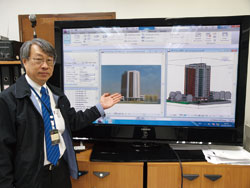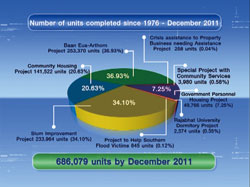| National Housing Authority Is Actively Utilizing BIM and VR |
National Housing Authority (NHA) is an organization of the Ministry of Social Development and Human Security, which was established in 1973 to provide housing for low and middle income groups. It also aims to improve people's lives and social and economic conditions by providing financial aids to those in need of their own houses, working with the construction and real estate industries, and eliminating or redeveloping slums.
From 1976 to 2011, they have provided about 600,000 housing units nationwide. The main breakdown of this is the construction of 253,370 units of low-cost housing, 233,964 units of house according to slum redevelopment, 141,522 units of community house, and 49,766 units of housing for government employees.
They also built university dormitories, worked on special community projects, supported flood victims in the south, and supported the real estate industry. They are also involved in sustainable urban development, including the support for the greening of residential areas and organizing competitions for clean urban development.
National Housing Authority has started to use BIM and VR to carry out these businesses efficiently.
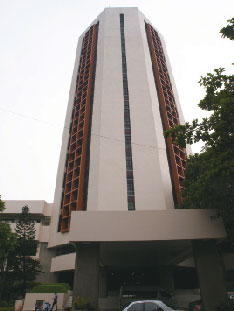 |
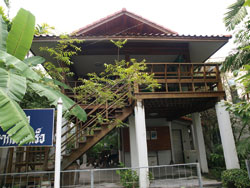 |
| £National Housing Authority's Head Office Building |
£A model house built by National Housing Authority. The house is raised-floor-style to prevent flooding. |
| Started From Creating VR For the Existing Projects |
"We are planning to use 3D technologies such as BIM and VR. We are in the process of introducing these technologies, and we are not at the stage of fully utilizing them yet. Since these are innovative technologies, the experts from our IT department are helping building designers to use them," explains Mr. Thawan Soonthornvinit, director of IT department of NHA.
NHA decided to introduce UC-win/Road, the realtime VR (Virtual Reality) software, in 2010. Next year, they purchased and started to use it for actual projects.
The procedure for using UC-win/Road is to first draw a 2D drawing, then select a model of buildings and place it on the plan view. This model is then turned into a realistic 3D VR model using UC-win/Road.
Their trial project is a housing project that has already been designed and completed using conventional methods. This time, they are verifying the effectiveness of that design while converting it into 3D using UC-win/Road.
"Animation software such as 3dsMax can produce high quality movies, but it takes much time, cost, and works. In this respect, UC-win/Road is great because it allows VR creation rapidly and easily at reasonable cost," says Mr. Soonthornvinit.
| Having A Software Training Facility For Designers |
They use the VR and animations they create to promote and sell their homes to the general public. "The VR presentations are very effective because we can see what the building will look like when we enter it, for example," said Mr. Soonthornvinit.
For a simple residential project, they have even created a VR in just three days. If they take more time and add more details such as movement, they can make the VR more realistic.
They also use Autodesk's BIM software "Revit Architecture" to create building models, which are then loaded into UC-win/Road. Also, they use plugins for "AutoCAD Civil 3D" to import civil engineering structures such as roads into UC-win/Road.
NHA has a software training facility in its office to educate building designers and civil engineers. "So far, we have trained 70 to 80 staff members in UC-win/Road and BIM software," said Mr. Soonthornvinit.
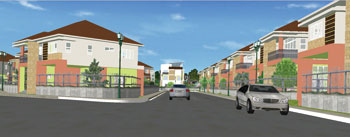 |
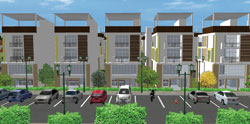 |
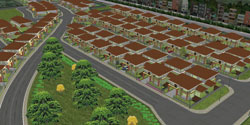 |
| £VR of a residential area created with UC-win/Road, showing that the company is also making efforts to green the residential area. | ||
| Also Introduced Driving Simulator |
They expect three main things for VR and BIM in the future. The first one is to improve the efficiency of design. They try to reduce the time for designing by 3D design. Second, by giving prospective customers a visual representation of the plans for the house, they aim to motivate them to buy and increase the closing rate. And lastly, they want to improve the efficiency of maintenance and management of rental housing. They believe that VR and BIM are effective tools to manage when and what kind of maintenance should be done after the housing is started to be used in use.
NHA has also installed a driving simulator from FORUM8. The simulator is currently undergoing testing, but in the future, they plan to use it for applications such as predicting traffic problems inside residential areas in advance.
After he tried UC-win/Road, Mr. Soonthornvinit commented "UC-win/Road is easy to use and will be very useful for realistically planning residential development projects. We would like to use more features in the future to see how it works."
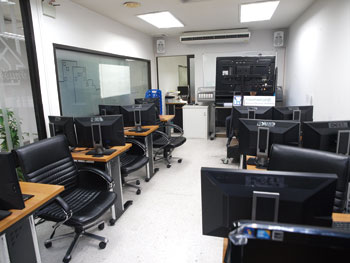 |
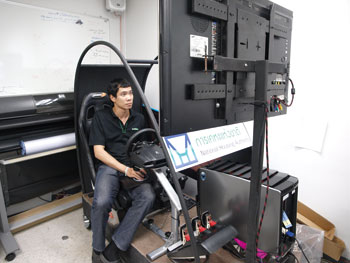 |
| £PCs are lined up in the training facility to teach staff how to operate BIM and VR (left). A driving simulator set up in one corner of the room (right). |
|
(Translation of the article written and interviewed by Mr. Ryota Ieiri, Ieiri Labo)
